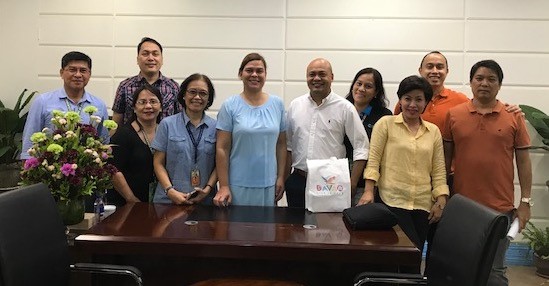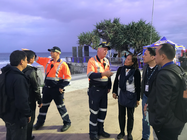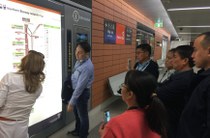Australian Government supports development of Davao City’s Transport Plan

In photo: Davao City Mayor Sara Duterte (center) together with the city’s benchmarking team headed by Atty. Tristan Dwight P. Domingo, Asst. City Administrator; P/Supt Dionisio C. Abude (Ret), Department Head, City Transport and Traffic Management Office (CTTMO); Atty. Joseph Dominic S. Felizarta, Department Head, City Engineer’s Office (CEO); Ivan C. Cortez Department Head, City Planning and Development Office; Gina Santos, Project Evaluation Officer II, City Planning and Development Office; Rowena Henedine D. Narajos, Information Technology Officer II, City Information Technology Center/Office. Also joining them were Atty. Zuleika Lopez, Davao City’s City Administrator; Mr. Nelson Salangsang, Manager of International Projects, Queensland University of Technology representative; and Ms. Theresa Sarona, Mindanao Engagement Manager, Australia Awards and Alumni Engagement Program – Philippines (AAAEP-P).
Mayor Sara Duterte expressed her gratitude to the Australian Government for assisting the city in enhancing its transport and traffic management plan. The benchmarking participants, who are back in Davao City, are in the process of improving the city’s plan using their key learnings from the mission.
“The benchmarking mission enabled the team to identify the depth and scope of

- Mr Brendan O’Keefe, Principal engineer, Policy and Strategy, Transport Planning and Strategy, Brisbane Infrastructure, Brisbane City Council spent time with the Davao City benchmarking team to assist them in identifying the structure, strategies, and processes underlying the development of the draft Brisbane Transport Plan. He also discussed travel demand modelling for Brisbane City Council, and accelerated procurement strategies that the council had to take to improve Brisbane’s public transport system.
Brisbane, which has the same population as Davao City, has implemented transport systems such as integrated transport ticketing between buses, trains and ferry services, and specialised busways and bikeways. One of the benchmarking participants, Engineer Gina R. Santos a project evaluation officer from Davao’s City Planning and Development Office, was particularly impressed with Brisbane’s strategy for accelerated procurement of buses and ferries to improve Brisbane City Council public transport. “Brisbane is successful in their transport implementation because they have a very good transport plan and they have the ATAP (Australian Transport Assessment and Planning) framework that guides them on the standards of planning,” she said. Inspired by Brisbane’s success, Engineer Santos said their meetings and data gathering are now guided by their learnings from Brisbane’s transport plan and strategic principles.
During the mission, the team also met with the Queensland Police Service-Traffic Enforcement. According to Engineer Santos, she was impressed by how the Queensland Police capture and use traffic and enforcement data to improve community safety, road safety measures, and traffic management. “Their priority is not just apprehension, but more importantly, safety of the road users and public,” she said.Meanwhile, Engineer Ivan Cortez who is the department head of Davao’s City Planning and Development Office, noted that the benchmarking mission helped him realise that active transport – such as walking and cycling – should be given full consideration in any infrastructure development and redevelopment. “Land use

- The officers explained how they manage the traffic flow in a major tourism thoroughfare at Surfers Paradise. The team also learned about traffic decongestion strategies including tactical urbanism technique.
Davao City’s benchmarking team was composed of department heads from the City Transport and Traffic Management Office, City Engineer’s Office and the CityPlanning and Development Office. While in Australia, the team conducted site visits of Brisbane’s and Gold Coast’s public transport system and met with senior city council officials responsible for transport planning and traffic management as well as private sector participants implementing traffic systems.
The benchmarking program was designed and conducted through the Australia Awards and Alumni Engagement Program Philippines (AAAEP-P) in collaboration with the Queensland University of Technology.


